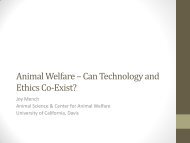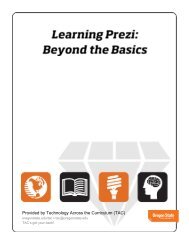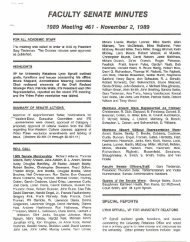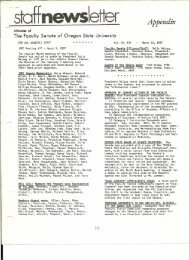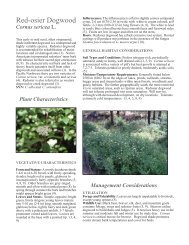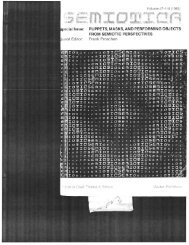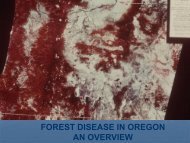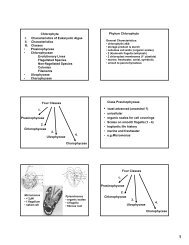available through Blackboard - Oregon State University
available through Blackboard - Oregon State University
available through Blackboard - Oregon State University
Create successful ePaper yourself
Turn your PDF publications into a flip-book with our unique Google optimized e-Paper software.
How Cosmology<br />
Became a<br />
id the unverse begi, or bas it<br />
always exsted? Sdentists long<br />
regarded ths question as lyig<br />
outside thei concer in the metaphysical<br />
real of phiosophers and theolo-<br />
gian. Not unti the middle of ths centu<br />
did physidsts and astronomers<br />
begi to equp themselves with theories<br />
power enough and exerental<br />
techques senitive enough to address<br />
the issue.<br />
Two competig cosmologies then<br />
emerged. One, popularly caled the big<br />
ban, assues tht the unerse evolved<br />
from inti conditions so hot and dene<br />
tht only radiation and elementar particles<br />
could exst; the unverse then expanded<br />
and cooled, predpitati the<br />
star and galaxes. The opposing model<br />
offers a unverse that has always exsted;<br />
the dispersal of matter resultig<br />
from the observed exanion of the<br />
unerse is compenated by the contiuous<br />
creation of matter.<br />
The big bang theory bas prevaed<br />
largely because of the prediction, observation<br />
and interretation of a phenomenon<br />
known as the cosmic background<br />
radiation. Ths radiation, widely<br />
regarded as the afterglow of the big<br />
Science<br />
The discovery of the cosmic microwave background<br />
in the 1960s established the 'big bang theory<br />
and made cosmology into an empirical science<br />
STHEN G. BRUSH has taught the hitory<br />
of sdence at the Uniersity of Marland<br />
at College Park since 1968. Before<br />
tht he conducted research in theoretical<br />
physics at Lawrence Uverore Laboratory<br />
and helped to wrte the tex for a<br />
school physics coure developed at<br />
hi<br />
Hard <strong>University</strong>. He has wrtten<br />
the development of the kietic theory<br />
of gases, the origi of the solar system<br />
and other topics in the history of moder<br />
physical sdence. He is spendi the<br />
1992-93 academc year at the Institute<br />
for Advanced Study in Prceton, N.J.,<br />
an how empircal tests afect sdentists'<br />
choice of theories.<br />
SCIC AMCA Augus 1992<br />
by Stephen G. Brush<br />
bang, suses the sky in al diections<br />
at micrwave frequendes. Aro A. Penzias<br />
and Rober W. Wilon of Bel laboratories<br />
discovered the cosmic back-<br />
ground in 1964-65 whie tr to<br />
rid<br />
thei radio anten of micrwave noise.<br />
The steady state model of the unverse<br />
predicted no such radiation and could<br />
not plausibly account for it. Thus, for<br />
the fist tie, hypotheses about the origi<br />
of the cosmos bad faced an empircal<br />
test tht left wier and a loser.<br />
Rarely do theories stand or fal on<br />
the outcome of a sine test. Th tie,<br />
however, opinon shited alost overnit.<br />
With a few year, most cosmologits<br />
had either adopted the big bang<br />
theory or ceased publihi in the field<br />
Pens and Wilon won the Nobel Pre<br />
in Physics in 1978 for their achevement.<br />
Just ths past Apri, measurements<br />
of miuscue varations in the<br />
backound radition vidicated another<br />
predicton of the big ban theory.<br />
Yet no one could have appredated<br />
the signcance of the cosmic microwave<br />
backound without the legacy of<br />
knowledge tht may other sdentists<br />
bad been buidi thougout the centu.<br />
The history of the discover yields<br />
another kid of inight. By followi<br />
the story past 1965 to see how the discover<br />
afected the standig of rival<br />
cosmological theories, we can test competi<br />
ideas about the natue of scientic<br />
progress.<br />
Big ban cosmology began to come<br />
into foc in the 1930s, after Edwi P.<br />
Hubble, the ement Amercan astronomer,<br />
showed tht galaxes appear<br />
recede from one another and that the<br />
most distant ones recede at the greatest<br />
rate. Hubble fidi implies tht<br />
the unverse is exandig. it was also<br />
interreted to imply tht the cosmos<br />
had once been concentrated in a ver<br />
sma space at a defte tie. Alexander<br />
A. Friedman, a Russia physidst,<br />
and Georges Lemaitre, a Belgian priest,<br />
each used Al Eitei' s general theory<br />
of relatity to descre how such<br />
an exandi unverse might evolve.<br />
Nuclear physics played a role by providig<br />
the tools with which to model<br />
the sythesis of the elements frm fudamental<br />
parcles. Those tools sered<br />
not only George Gamow, chpion of<br />
the big bang, and his colleagues Raph<br />
A Alpher and Rober Heran but also<br />
Fred Hoyle then at the <strong>University</strong> of<br />
Camridge-who favored the rival '<br />
steady state theory.<br />
Vital to the theoretical work was the<br />
COSMC AUDITRS Amo A. Pen.<br />
(left) and Rob W. Win (riht) of Bej'<br />
Laboratories pose on the micrwave.<br />
horn anten (show on this page) tht .<br />
fit cupped an ea to the big ba. '<br />
contrl<br />
Planck :<br />
centu<br />
of blad<br />
gets its<br />
er<br />
tion ani<br />
diated E<br />
spect<br />
ter pI<br />
priOl!<br />
would I<br />
perect<br />
radiatic<br />
plosioD<br />
the blal<br />
Sti t<br />
cuatioJ<br />
patter
contrbution that Eistei and Max<br />
Planck made around the tu of the<br />
centu whie formulati the physics<br />
of blackody radiation. The blackbody<br />
gets its. name from its idealed propert<br />
of absorbin al incomig radiation<br />
and then reradiatig it. This reradiated<br />
energy is distrbuted across the<br />
spect in a high chacterstic patter<br />
predicted by Planck. Because the<br />
priordial fiebal, in its early phases,<br />
would bave put energy and matter into<br />
perfect thermal equbrium the fist<br />
radiation liberated from the cooli explosion<br />
would bave to have displayed<br />
the blackody patter<br />
Sti to be supplied was a predse calcuation<br />
of how energetic that spectral<br />
patter would appear today, many bil-<br />
lions of years afer the fiebal began to<br />
exand and cool. Wht was the temperatue<br />
of the radiation in space? An answer<br />
to that question could come only<br />
after sdentists developed a quantitative<br />
theory of the evolution of the fie-<br />
bal after the big bang.<br />
. The development of th quantitative<br />
theory began with Gamow, a Russianborn<br />
physicist who bad made his reputation<br />
by exlai radioacte decay.<br />
In the 1930s he came to the U.S., teachin<br />
fist at George Washigton Uniersity<br />
and then at the <strong>University</strong> of Colorado.<br />
At George WasbIon, he concentrated<br />
on the astrophysical and cosmological<br />
as of nuclea reactonsabove<br />
al the mechms by which the<br />
fit elements bad bee sythesized.<br />
Gamow looked for his answer at<br />
both ends of the cosmic scale. In the<br />
early 1930s astronomers showed tht<br />
most stars were composed predominantly<br />
of hydrogen andhelwn It was<br />
reasonable to assue tht hydrogen<br />
was the fist element to form because<br />
its nucleus contai but sie proton<br />
and tht hel-the nex heaviest element,<br />
whose nucleus contai two protons<br />
and two neutrons-was the fist<br />
higher" element formed by the fusion<br />
of hydrogen But protons wi fuse onl<br />
if some force overcomes the imense<br />
electrostatic repulsion between them<br />
Th process seeed to requ so much<br />
heat and pressue tht only a priordi<br />
event or the interor of a star could bave<br />
provided the rit conditions.<br />
SCIC AMCA Augu 1992
i' ,.<br />
- '- . ' ' - ' . --,"'" - , - - - . - '- . " , - . . ' - - - - - .-=-..= -:- =-.. ---<br />
Sl AN NONSESE In a montage he made to amus<br />
frends, George Gamow emerges, genete, frm a botte of<br />
the prieva matter created in the big ba He is conju<br />
The reigng theory of the nuclear<br />
phy&ics of stars, which rem for the<br />
most par vad today, bad been developed<br />
in 1938 by the Ge-born physicist<br />
Han Bethe of Cornel <strong>University</strong>.<br />
Bethe wated to exlai how the<br />
shies. He did so,by assum tht nuclear<br />
fuion in stelar interors convers<br />
mass into energy. Spedfcaly, Bethe<br />
proposed tht two fusion reactons<br />
could take place in stars lie the<br />
one fuses protons into helum nuclei,<br />
and another adds protons to carbon<br />
nucleito form heavier elements.<br />
But where did the carbon origite?<br />
Tht question was not anwered unti<br />
the 1950s, when Hoyle proposed a reacton<br />
tht could produce carbon from<br />
thee helum nuclei under the spedal<br />
conditions found at the core of a star.<br />
Tht recton and others needed to<br />
ate heavier elements wer confed ex-<br />
SCIC AMCA Augu 1992<br />
perentaly, in a hi-eergy parcle<br />
accelertor, by Wilam A. Fowler and<br />
hi group at the Calorn Intitute of<br />
Techology. Hoyle and E. E. Sapeter<br />
provided important theoretical help.<br />
19.57 a scheme exla how stars<br />
might bave sythesized most of the elements<br />
from hydrogen .and hel bad<br />
been worked out by Fowler, Hoyle and<br />
Margaret Bubidge of Caltech together<br />
with Geoffey Bubidge, then at the<br />
Mount Wilson and Paoma obsertories.<br />
The work was done independently<br />
by A. W. Camern, then at Atomic En<br />
ergy of Canda. Yet the cosmic abundace<br />
of hel remed a myster.<br />
Gaow bad alady formulted a dain<br />
hypthesi tht ultitel led to the<br />
solution of the he1 puzzle. In his<br />
verion of the big bang, Gamow suggested<br />
tht the elements might bave<br />
formed even beore the star came into<br />
up by Robe Her (at left and Rah A. .Apher (at riht)".<br />
wh showe ho such matter-whch they ca "yem<br />
could have combin to form the lit elements<br />
be, in a stupendously hot and den<br />
gas of neutrons. Some of the neutrons<br />
would then bave decayed into protons<br />
and electons-the buidi bloc of<br />
hydrogen In 1948 Gamow, known<br />
hi impatience with detai as wel as .<br />
hi brice, assigned the task of ,<br />
velopin the theory to Raph Alpher,<br />
graduate student at Gerge Was<br />
ton. Alher later joined forces with It ,<br />
er Heran of the John Hopki U<br />
verity Applied Physics Laorato<br />
Alphergave Gamow s intial sust<br />
the nae "ylem" frm a Greek w<br />
mean "priordi matter.<br />
cordi to Gamow s theory<br />
worked out by Alpher and<br />
ma larer nuclei formed in<br />
priev inero when smaer<br />
begi with hydrgen grw<br />
the successive captue of neutrIi.<br />
process<br />
free ne1<br />
fel and<br />
Hoyll<br />
riva t(<br />
io by co<br />
attemp<br />
was Sl<br />
cates c<br />
Alpl<br />
thttl<br />
el un<br />
tr'<br />
Moree<br />
exax<br />
atten<br />
its tel<br />
esti<br />
ter b<br />
pe1<br />
atioI<br />
five<br />
solu<br />
the<br />
did<br />
mic<br />
sou<br />
tak<br />
the<br />
Vel<br />
pI,<br />
fl'
process contiued unti the supply<br />
free neutrons ran out, the tempeatue<br />
fel and the parcles dispersed<br />
Hoyle attempted to beltte ths new<br />
riva to hi own steady state scenio<br />
by cal it the big ban theory. The<br />
attemt at ridicue backd: the phrse<br />
was so vivid tht the theory s advocates<br />
adopted it as thei own<br />
Alpher and Her soon realed<br />
thtthe radition perdi thei modelunverse<br />
would maitai the spectr<br />
of a blackod soure as it cooled<br />
Moreover, they could calcuate how the<br />
exansion of the unverse would bave<br />
attenuated th radition and reduced<br />
its tempeatu. The two scientits<br />
estites of the present denty of matter<br />
in the unverse to predict the tempetu<br />
of the cosmic backun radiation<br />
tody and dered a vae of abt<br />
five kelvi (degrees Celsius above absolute<br />
zer).<br />
Astronomers did not ruh to conf<br />
. the predicton, perbaps because they<br />
did not knw how to pick out the cosmic<br />
backgrund frm other raditie<br />
soes or pebaps beau they di not<br />
take serously the cosmology on which<br />
the predicton was based The origi<br />
on of the big ban theory bad two<br />
ajor drawback. First, :it faied to ex-<br />
'/ai the formation of the elements be<br />
yond helum which bas a mass number<br />
of four. Because there are no stable<br />
isotopes bavig mass nums<br />
five and eight, one canot mae heavier<br />
elements out of hel by addi<br />
neutrons one at a tie. Th problem<br />
could be solved only by invoki the<br />
stel nudeosythesi of Hoyle, Fowler<br />
and thei collaborators, a concept associted<br />
with the steady state theory.<br />
Indeed, the moder version of the big<br />
ban theory assues tht elements<br />
yond helum arose only after the formation<br />
of the fit generation of stars.<br />
A second objecton to a big ban unverse<br />
involved the question of age.<br />
tronomical measuements of the distances<br />
and recessiona speeds of galaxes,<br />
in conjuncton with Hubble s law<br />
of exanion, implied tht the unerse<br />
was two bilon year old Yet the roc<br />
of the ear' s surace prove tht the<br />
planet is signcantly older th tht.<br />
The steady state theory wa concei<br />
to resolve ths apparent contradiction.<br />
One night in 1946, thee youn sdentits<br />
in Camridge, End-Hoyle,<br />
Heran Bondi and Thomas Gold-<br />
went to see a ghost story fi<br />
Dead<br />
l'Jht. As Hoyle later realed the movie,<br />
bad four separate pars lied ingenously<br />
together in such a way tht<br />
the fi became cicuar, its end the<br />
sae as its begig." Gold asked<br />
friends whether the unverse might be<br />
simarly constrcted In the<br />
dicussion the worker sketched out a<br />
dyc but noncydic model of the unverse<br />
tht would always look the same<br />
even thoug it is always ch:mEing<br />
Accordi to Hoyle, Bondi and Gold,<br />
the unvere bad no begi.They argued<br />
tht the gales' rushig away<br />
from \is does not imply a contiuous<br />
attenuation of matter our own gal<br />
wi never be left al alone, they sad,<br />
beause matter is be crted contiuously,<br />
at a rate just sudent to compente<br />
for the matter tht is diappear<br />
from the viible unvere. Ths<br />
new matter wi eventuy form sta<br />
an gaes so tht th unere wi always<br />
look about the sae to any obserer<br />
at any tie.<br />
One might objec tht the cration of<br />
matter out, of noth violates the law<br />
of consertion of mass. and energy.<br />
The riposte is obvious: the big ban<br />
also violates th law and does so by<br />
creati matter al at once, at the begini<br />
of tie, when the act is bend the<br />
reach of sdentic study. (In a later version<br />
of the steady state theory, Hoyle<br />
proposed-tht grvitationa energy creates<br />
matter, a reement tht restores<br />
the overal consertion of mass-eergy<br />
but introduces other problem)<br />
roponents of the steady state assered<br />
tht thei theory wa more<br />
sdentic th the big ban because<br />
it postuted a process-contiuous<br />
creation-tht might in pridple<br />
be obsered Moreover, they argued,<br />
thei theory made defte predictons<br />
of a kid tht astrnomer could test<br />
in the nea futue.<br />
In sta thei moel on the outcome<br />
of a sm nu of obsetions, Bondi<br />
Gold and other proponents of the<br />
steady state model exlicitly invoked<br />
the doctre of Kal Popper, an Austran-born<br />
phiosopher now livig in England<br />
Popper defes science as a didplie<br />
founded on the cration of hy-<br />
potheses tht predict phenomenpreferably<br />
new ones-tht can be tested<br />
If a prediction fais, the scientit<br />
abadons the hypthesi; if the hypthesi<br />
surves, the sdentist does not<br />
clai to bave proved it but merely to<br />
bave establihed the hypothesis as a<br />
basis for fuer research<br />
Poppers priciple holds tht testabilty<br />
rather th trth should be the<br />
crteron for judgi sdentic theories.<br />
For intance, Poppe dimisses Marism<br />
and psychoanys as "pseudoscience"<br />
because he beleves those theories<br />
ar so flexle tht they can expla<br />
any fact and thus elde any test.<br />
Bondi proposed to cheie the<br />
steady state theory by compar the<br />
unerse as it is with the unerse as it<br />
once was. Because the steady state theory<br />
says the unverse always looks the<br />
same, it predict tht galaxes formed<br />
recentl wi resemle those formed<br />
long ago. If you look out into spaceand<br />
thus back in tie, because the<br />
speed of lit is fite-and see tht<br />
ditant gaes ar diert frm neaby<br />
ones, Bondi conclded, "then the<br />
steady-state theory is stone dead" Lie<br />
other wrti before 1965, however,<br />
Bondi faied to mention another test of<br />
the steady state model it does not pre<br />
dict 'a cosmic microwave backund<br />
The theory faied the test Bondi had<br />
set it. In the 1950s and early 1960s a<br />
vaety of astrnomical obsertions<br />
showed tht the unere bad ched<br />
signcantl over tie. Ma Ryle of<br />
Camridge counted both ditant and<br />
neary radio soures, knowi tht the<br />
more ditant sig had taken longer<br />
to arve and thus refected an earlier<br />
stage in cosmic hitory. Ryle conclded -<br />
tht ther bad be fewer sources in<br />
the past. Although some astronomers<br />
argued tht he bad not proved hi cae,<br />
additiona support evdence emered<br />
when astronomer discovered wbat<br />
seemed to be the oldest radiative<br />
sources-quasistel objects, or qua-<br />
SCIC AMCA Augu 1992
FR HOYL chpion of the steady state , conceived of the theory with<br />
Her Bondi and Thomas Gold in 1946, afer the thee had seen a ghost story<br />
fi whose plot ended in a retu to the ope scene.<br />
sars. These objects bad no contemporar<br />
paralel wbatsoever.<br />
Meanwhie the awkward issue of the<br />
disparty between the age of the unverse<br />
and the age of the ear was resolved<br />
in a way tht favored the big<br />
ban. In 1952, followi the lead ofWalter<br />
Baade of the Mount Wilson Observatory,<br />
astronomers revised thei scale<br />
of galctc distances upward by a factor<br />
of two. The estiated age of the<br />
unverse therefore doubled. Later work<br />
raised it to a mium of 10 bilon<br />
years, whereas the age of the ear remaed<br />
fied at 4.5 bilon year.<br />
Yet many sdentists, parcuarly in<br />
Brtai lied the simplidty of the steady<br />
state theory and so contiued to di<br />
the concept. They pointed out tht one<br />
did not bave to make arbitrar assuptions<br />
about a big ban or worr about<br />
wbat happeed before the big ba. Advocates<br />
of the steady state model also<br />
took hear from the faiure of earlier attempted<br />
reftations, a record tht made<br />
them suspidous of any new attack.<br />
As the steady stater spt ever more<br />
tie exlai away the evidence accumulati<br />
agait thei theory, thei adherce<br />
to Poppes methodology steadily<br />
became less credible. Intead they<br />
seemed to be ilustratig Planck's more<br />
cycal view of sdence. Writig in<br />
Sdentific Autobiography and Other Pa-<br />
SCIC AMCA Augus 1992<br />
pers (1949), the great physidst argued,<br />
A new sdentic trth does nottrumph<br />
by convidng its opponents ard<br />
mak them see the light, but rather<br />
because its opponents eventualy die<br />
and a new genertion grows up tht is<br />
famar with it.<br />
lanck' s pridple, as historian of<br />
science now cal it, contradicts<br />
Poppers pridple by emphasizing<br />
the human element in sdence to<br />
the detrent of abstract logic. Just as<br />
astronomers can weigh the big bang<br />
agait the steady state as a descrption<br />
of the unverse, so may historian of<br />
sdence tr to dedde between Planck'<br />
and Popper s descrptions of sdence.<br />
Let us see which seem more accute<br />
in ths' parcuar case, without undertak<br />
to judge whether sdence always<br />
works in ths way.<br />
In 1959 a suey showed that a majority<br />
of astronomers rejected contiuous<br />
creation, although only a thd of<br />
those voti actaly favored the big<br />
ban. Even Hoyle abandoned his original<br />
model and replaced it with a more<br />
complicated hypthesis. In 1964 he concluded<br />
tht the hi abundance of helum<br />
in the unerse implied it bad been<br />
cooked" at tempeatues exceedi<br />
10 10 kelvi. Yet Hoyle refsed to abandon<br />
the idea of the contiuous creation<br />
of matter. A new shock was needed.<br />
The discover of the cosmic microwave<br />
backound provided tht shoc<br />
Penas and Wilson made the discover<br />
by measu the temperatue of<br />
space or, as a physicit would say; by<br />
detectig the Planck blackody spectral<br />
distrbution tht corresponds to a<br />
parcu temperarue. Electomagnetic<br />
radiation perades the regions between<br />
the planets and the stars, and it<br />
can be detected by intrents on the<br />
ear Much of th radition comes in<br />
spedfc frequendes detered by the<br />
physical and chemcal properes of astrnomical<br />
soures. It th canot be accuately<br />
chactered by a sine tempertue.<br />
Intead investigators look for<br />
radiation tht is in ther equri<br />
at a parcuar temperatue. Tht is to<br />
say, the radiation is contiuously ditrbuted<br />
over dierent frequendes aC-<br />
cord to the law dicovered by Plack<br />
in 1900. .<br />
The Plack ditrution ha a ch-<br />
actertic sbape for ever temperatue<br />
(see ilusation on opposie pagel. For<br />
the unverse in which we live , the background<br />
radition corresponds to a tempedtu<br />
slitl less th th kel.<br />
The distrution peak at a wavelen<br />
of about 0.18 centieter, which is in<br />
the microwave region of the spect<br />
One can iner a tempertu of space<br />
indiecty. As Arur Staney Eddion<br />
pointed out in 1926, the amount of<br />
light comi from al the stars-tht<br />
is, the total energy denity-would be<br />
equvaent to 3. kelvi if convered to<br />
ther equrium But Eddion did<br />
not propose a spedfc procedure for<br />
testig hi predicton. .<br />
At tht tie, even a sdentit of Eddigton<br />
s cah"ber would bave found the<br />
task daunti. Obviously, ordi ther- ,<br />
mometers would be swamped by energy<br />
comi from the su other celestial<br />
objects and the ear' s atmosphere.<br />
On excee senitie intrents<br />
tued to wavelength between a milieter<br />
and a centieter and inated<br />
from local sources, can hope to detect<br />
the cosmic micrwaves.<br />
About 15 year afer Eddion made<br />
hi presdent predcton, Andrw McKellar<br />
of the Domion Astrophysical Obseratory<br />
in Canada suggested a practical<br />
way to measue wbat he caled the<br />
efectie temperatue of space. McKel- .<br />
lar, one of the fit astronomer to pro<br />
pose tht molecues as wel' as atoms<br />
could exst in intertelar space , sugested<br />
tht the cyogen (CN) molecue '<br />
be employed as a therometer. He not- .<br />
ed tht cyogen emts spect lies<br />
whose relatie intenity corresponds to<br />
the num of electons in hier-eer- :<br />
gy states itself a fucton of the tem-<br />
:::<br />
peratu<br />
tht ten<br />
ThesE<br />
rue Oul<br />
es. To c<br />
dition<br />
Radar<br />
saChuse<br />
in WOJ<br />
ble of s<br />
diecty<br />
look fOJ<br />
In 19<br />
Rober<br />
ic radia<br />
micrOWi<br />
that thE<br />
ter at tl<br />
qute SJ<br />
of 20 ke<br />
obser<br />
moved<br />
caled t<br />
sueme:<br />
big ban<br />
ble glm<br />
galaxes<br />
Steve:<br />
First Th<br />
sons wi<br />
sear<br />
before<br />
lost SOl:<br />
exlai<br />
ier<br />
importa<br />
dictons<br />
stacosmol(<br />
heavy ei<br />
frm<br />
though<br />
um bad<br />
Seon<br />
down 0:<br />
orists a:<br />
rits dic<br />
the radi<br />
and the<br />
the sigr<br />
From tb<br />
tht Die<br />
an ex<br />
role: to<br />
he help<br />
wave no<br />
The )<br />
POrtl<br />
standi<br />
Althoug<br />
All<br />
- PrE
. -<br />
peratue of space; McKelar estiated<br />
tht temp tU to be 2.3 kelvi.<br />
These indiec approaches could not<br />
rue out intererence frm local sources.<br />
To do tht, one must detect the radition<br />
itsel and map it across the sky.<br />
Radar equpment developed at the Massachusetts<br />
Intitute of Tecology duin<br />
World War n was just barely capable<br />
of senin the cosmc backound<br />
diecty-for anyone who wated<br />
look for it. .<br />
In 1946 a group at M.lT., led by<br />
Rober H. Dicke, reported annospheric<br />
radiation measuements taken by a<br />
microwave radiometer. The team noted<br />
tht the "radiation frm cosmic matter<br />
at the radiometer wavelen" was<br />
qute spare-less th the equvalent<br />
of 20 kel-but did not follow up<br />
obsertion. Dicke, who susequently<br />
moved to Prceton Uniersity, later recaled<br />
tht "at the tie of ths measuement<br />
we were not thg of the<br />
big ban' radiation but onl of a possible<br />
glow eJtted by the most ditant<br />
gales in the unerse.<br />
Steven Weig, in his book The<br />
First Three Minutes, suggests two reasons<br />
why no one made a systematic<br />
search for the backound radiation<br />
3efore 1965. First, the big ban bad<br />
lost some crediilty when it faied to<br />
exlai the formtion of elements heavier<br />
th hel so tht it did not see<br />
inportt to test the theory s other predictons.<br />
In contrast, nucleosythes in<br />
stars-a theory lied to steady state<br />
cosmology-seemed to exlai how<br />
heavy elements could bave been made<br />
from hydrogen and hel even<br />
though it did not exlai how the helum<br />
bad formed in the fist place. .<br />
Seond, Weierg points to a breakdown<br />
of communcation between theorists<br />
and exentalsts. The theorists<br />
did not realze one could obsere<br />
the radiation with exti equpment<br />
and the exerentalts did not reale<br />
the signcance of thei obsertions.<br />
From ths perspective it is noteworty<br />
that Dicke, who is both a theorist and<br />
an exerentalst, played a major !:<br />
role: together with P. James E. Peebles, 104<br />
he helped to relate a pecuar micro-<br />
wave noise to cosmological theory.<br />
The most remkable mised op-<br />
portty resuted from a mider-<br />
standig between Gaow and Hoyle.<br />
Although each crticied the other<br />
theory, they could sti. bave frendly<br />
dicussions. In the suer of 1956<br />
\:;amow told Hoyle tht the unerse<br />
' must be fied with microwave radiation<br />
. at a temperatue of about 50 kelvis.<br />
(He ared at th estite on hi own<br />
afer Alpher and Her bad publied<br />
thei predicton.)<br />
. As itbappened, Hoyle Was famar<br />
with McKelars proposa tht the temperatu<br />
of space is about thee kelvi.<br />
So Hoyle argued tht the tempertue<br />
could not be as high as Gamow<br />
claied. But neither of them realzed<br />
tht if a diect measuement could confi<br />
the thee-kelvi vaue and also establih<br />
the Plackan spec it would<br />
refte the steady state theory, whichas<br />
Hoyle recognzed-predicts a zero<br />
tempetue for space.<br />
A dierent kid of communcation<br />
problem-satelte relys-did lead to<br />
the discover of the cosmic microwave<br />
background. Bell Labs wated its sateltes<br />
to convey as much inormtion<br />
as possible at microwave frequendes, a<br />
task tht requed its workers to fid<br />
and elte noise from al sources.<br />
The relay hadwae, dervi from the<br />
fi' s War-relted work on radar, consisted<br />
of a horn-sbaped receiver tht<br />
Bel Labs eneers Harald T. Fri and<br />
A. C. Beck bad buit in 1942. Another<br />
Bel Las engieer, Arur B. Crawford,<br />
cared the idea much fuer. In 1960<br />
he buit a 20-foot horn receier at the<br />
Crwford Hi facity near Holmdel,<br />
NJ. Tht refector, oriy used to receie<br />
signals bounced frm a plastic<br />
baloon high in the annosphere, ' became<br />
avaiable for other puroses just<br />
in tie for Penzas and Wilson.<br />
he two investigators wanted to<br />
star a research progr in radio<br />
astronomy. To prepare the hily<br />
senitive intrent for thei work,<br />
Pens and Wilson fist bad to rid it of<br />
microwave noise. They faied in thei<br />
fist few attempts. Finaly, in Januar<br />
1965, Fens heard tht Peebles bad a<br />
theory tht might exla the origi of<br />
the stuborn peristent sig<br />
106<br />
102<br />
103 10<br />
108<br />
Peebles was workig with DiCke at<br />
Prceton, about 25 mies from the<br />
Holmdel laboratory. Dicke rejected the<br />
assuption tht the unerse necessa<br />
ily began with the big ban. He thought<br />
it more liely tht the unverse went<br />
though pbases of exanion and contrcton.<br />
At the end of each contrcton,<br />
he conjectued, al matter would pass<br />
though temperatues and denities intene<br />
enoug to bre down the heavier<br />
nuclei into protons and neutrons.<br />
Thus, although Dicke s unverse did<br />
not star with a big ban, each of its<br />
cycles must begi in a simar cata-<br />
clys Moreover, Dicke s cosmology im<br />
plied an intial fiebal of high-temperatue<br />
radiation tht retai its Plack<br />
blackody chacter as it cools down<br />
and he estited tht the present temperatue<br />
of the radiation would be<br />
kelvi. He evidently bad forgotten<br />
own 1946 measuement tht suested<br />
the exstence of backund radiation<br />
at a temperatue less th 20 kelvi.<br />
Peebles made fuer calcutions from<br />
Dicke s theory and obtaied an estimate<br />
of about 10 kelvi.<br />
Dicke and Peebles, together with two<br />
graduate students, 'P. G. Roll and D. T.<br />
Wilon, then stared to constrct an<br />
anten at Prceton to measue the<br />
cosmic backund radiation. Before<br />
they bad a chce to get any resuts,<br />
Dicke receied a cal from Pen, suggesti<br />
they get together to dicuss the<br />
noise in the Crwford anten corr<br />
spondi to a tempertu of about 3.<br />
kel. It was soon apparent tht Pen<br />
zias and Wilson bad aleady detected<br />
the radiation predicted by Dicke and<br />
Peebles and earlier by Alpher and Herman<br />
But unti the two astronomers<br />
taled to Dicke and Peebles, they did<br />
not knowwbat they bad found The<br />
FREQUENCY (CYCLES PER SECOND) 108 10w 1012<br />
WAVELENGTH (CENTMETERS)<br />
BlACKODY SPECTUM prected by the big ba theory implies tht the earlies<br />
radition in the uner wi now appe to be emti frm a soe a few degrs<br />
above absolute zer Pens and Win confed the sp at a sie<br />
point; other have sice confed it for a wide rae of frencies.<br />
SCc AMCA Augu 1992
Selection from George<br />
Gamow's Mr Tompkins<br />
in Paperback<br />
Your years of toil,<br />
Said Ryle to Hoyle,<br />
Are wasted years, believe me.<br />
The steady state<br />
Is out of date<br />
Unless my eyes deceive me<br />
My telescope<br />
Has dashed your hope;<br />
Your tenets are refuted.<br />
Let me be terse:<br />
Our universe<br />
Grows daily more diluted!"<br />
Said Hoyle, "You quote<br />
Lemaitre, I note,<br />
And Gamow. Well, forget them!<br />
That errarit gang<br />
And their Big Bang-<br />
Why aid them and abet them?<br />
You see, my friend<br />
It has no end<br />
And there was no beginning,<br />
As Bondi, Gold,<br />
And I wil hold<br />
Until our hair is thinning!"<br />
Not so!" cried Ryle<br />
With rising bile<br />
And straining at the tether;<br />
Far galaxies,<br />
Are, as one sees,<br />
More tightly packed together!"<br />
You make me boil"<br />
Exploded Hoyle,<br />
. His statement rearranging;<br />
New matter's born<br />
Each night and morn<br />
The picture is unchanging!"<br />
Come off it, Hoyle!"<br />
I aim to foil<br />
You yet" (The fun commences)<br />
And ina while,"<br />
Continued Ryle,<br />
ll bring you to your senses!"<br />
Verses by Barbara Camow<br />
theoretical interretation was essential<br />
to tu mer detecton into tre dicover.<br />
Tht discover came more th a<br />
decade late because the scientic world<br />
bad simply overlooked the earlier work<br />
by Gamow, Alpher and Her<br />
The reports of the groups from Bel<br />
Labs and Prceton were sent to the As-<br />
SCIC AMCA August 1992<br />
trophysical Journal in May 1965 and<br />
appeared together in the July 1 issue.<br />
Publication uneashed a flood of arcles<br />
in both the mass media and the<br />
sdentic jourals. Even Hoyle admtted<br />
tht the steady state theorY, at least<br />
in its origial form<br />
, "<br />
wi now have<br />
be discarded , n although he later tred<br />
to han on to a modied version tht<br />
could exlai the microwave radiation.<br />
But Bondi's empbasis on the testabilty<br />
of the steady state theory bad come<br />
back to haunt its proponents. Any attempt<br />
to twt the theory to exlai the<br />
new discoveres riked beig labeled<br />
pseudosdence.<br />
Although the press was quck to condude<br />
tht Penas and Wilson bad confied<br />
the big ban defitively, sdentits<br />
reed tht thei resuts were liitedJo<br />
only a few wavelen clustered<br />
atone end of the Planck cue. Other<br />
exlanations of the background radiation,<br />
such as a combintion of radio<br />
sources, could exlai those data<br />
points. It was not unti the mid-1970s<br />
that enoug measuements at dierent<br />
frequencies bad been made to convice<br />
the skeptics tht the background radiation<br />
actaly follows Planck's law. The<br />
spectr of the CN molece played an<br />
important par here, as astronomers<br />
resuected and buit on the earlier<br />
work of McKelar.<br />
By the late 1970s nearly al the origina<br />
supporters of the steady state model<br />
had exlidtl abandoned it or simply<br />
stopped publishig on the subject. A<br />
surey of Amercan astronomers conducted<br />
at tht tie by Carol M. Copp of<br />
Calorna <strong>State</strong> <strong>University</strong> at Fuleron<br />
found tht a large majority supported<br />
the big ban over the steady state.<br />
The rapid demse of the steady state<br />
theory after 1965 shows tht Popper<br />
pridple, rather than Planck's, applies<br />
in th case. The dicover of the cosmic<br />
microwave backound, combined with<br />
arguents about helum abundance<br />
and obsertions of ditant radio soures<br />
and quasars, conviced most steady<br />
staters that thei theory was no longer<br />
wort pursuig. It bad been tred and<br />
found wati.<br />
Yet in 1990, when the steady state<br />
theory was al but forgotten, Hoyle and<br />
a few of his colleagues tred to revive it<br />
as a "mi-big bang" theory, argug<br />
tht the evidence d s not support the<br />
hypothesis tht a single exlosion created<br />
every. Geoffey Burbidge recently<br />
sumarzed ths view in an essay<br />
in these pages (see "Why Only One<br />
Big Ban?"; Februar).<br />
Although proponents of the big ban<br />
could dismiss most such crtidsms,<br />
some puzzles sti remaied unolved.<br />
For exple, the microwave backund<br />
seemed too smooth It lacked the slight<br />
vaations in temperatue and, by implication,<br />
in denty tht seemed necessar<br />
to seed later gravitational clumpin.<br />
Without such seedig, there would<br />
not bave be sudent tie to produce<br />
the galaxes and supergalactic strctues<br />
now obsered.<br />
hen, in Apri of ths year, George<br />
P. Smoot and hi colleagues at<br />
the <strong>University</strong> of Calorna at<br />
Berkeley and at the Lawrence Berkeley<br />
Laboratory released evidence tht may<br />
fi ths gap in the big bang theory.<br />
They anounced an anysis of measurements<br />
of the cosmic backound<br />
radiation gathered by an orbiti obsertory<br />
caled the Cosmic Background<br />
Exlorer (COBE).<br />
The data showed slit<br />
temperatue vaations in the cosmic<br />
backound, just as bad been exected.<br />
by big bang theorists. The researchers<br />
interret these "rpples" as flctuations<br />
in the denity of matter and energy in<br />
a ver early pbase of cosmic hitory.<br />
Such ripples may help exlai how<br />
matter clumped under the force of its<br />
own gravitY in tie to form the stars,<br />
galaxes and larger strctus of the<br />
contemporar unverse.<br />
Did the unverse realy begi at the<br />
big bang, or was there a previous contraction<br />
phase-a "big crch" tht<br />
led to the high temperatue and density?<br />
Wil the unverse contiue to expand<br />
forever, or wi it eventualy collapse<br />
into a black hole? Does the creation<br />
of the unverse involve quantu<br />
theory in a fudamental way? These<br />
ideas now domiate physical thought<br />
(see "Quantu Cosmology and the Cre- .<br />
ation of the Universe," by Jonath<br />
Halwel; SOEC AMCA, December<br />
1991). Tht sdentits consider such<br />
questions worty of serous investigation<br />
is itsel largely a consequence of<br />
the dicover of the cosmic microwave<br />
backgound,' which tranformed cosmology<br />
into an empircal sdence.<br />
RJTI REING<br />
IN SEACH OF TI BIG BANG: QuAN<br />
PHcs AN COSMOWG. John Gribin<br />
Bantam Books, 1986.<br />
'f COSMC MICROWAVE BACKGROUN:<br />
25 YEA LATE. Edited by N. Mandolesi<br />
and N. Vittorio. Klwer Academc Publishers,<br />
1990.<br />
MODER COSMOLOGY IN REOSPCI.<br />
Edited by B. Berott et al. Camridge<br />
<strong>University</strong> Press, 1990.<br />
'f CA FOR TI RETIC HOT BIG<br />
BANG COSMOLOGY. P. E. Peebles, D. N.<br />
Scham E. L. Tuer and R. G. Kron<br />
in Nature, VoL 352, No. 6338, pages<br />
769-776; August 29, 1991.<br />
We are li<br />
our ancest(<br />
ined. It is a .<br />
tht cou1dr<br />
In a cent<br />
with fateand<br />
plenty,<br />
have with<br />
meas to gi<br />
the vita<br />
The agel<br />
We must cc<br />
have the tee<br />
. a tre dialo<br />
al levels<br />
. offces , hea




